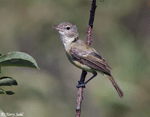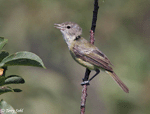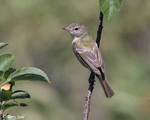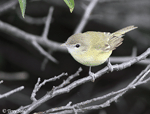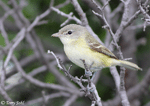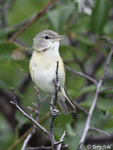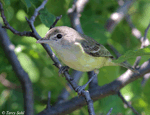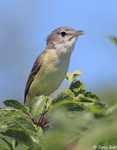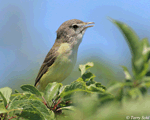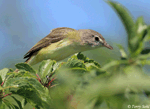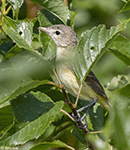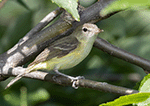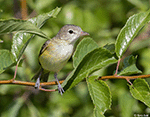| Length: 4.75 inches | Wingspan: 7.5 inches | Seasonality: Summer |
| ID Keys: Generally plain, with dull wing bars, weak eye-ring, greenish-gray back, white to yellow underparts. | ||
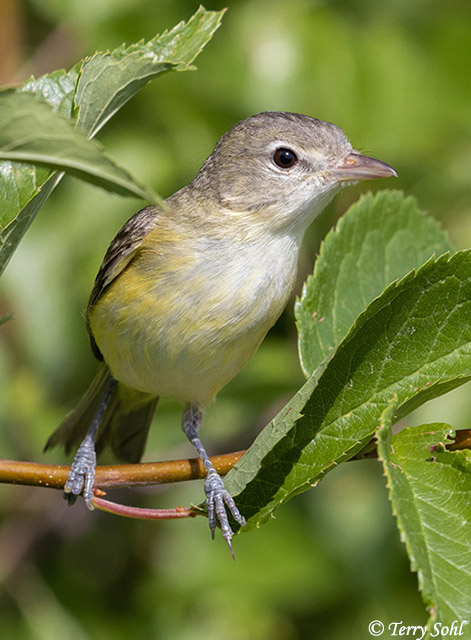 Often heard but not seen,
the Bell's Vireo is often heard singing its repetitive, jumbled song from low
brushy thickets, where they seem to first be asking themselves a question (with
an up-raised note at the end of the first jumbled phrase), and then pause and
provide an answer to their own question. In South Dakota, they are a
relatively common summer breeding resident in southern parts of the state.
Often heard but not seen,
the Bell's Vireo is often heard singing its repetitive, jumbled song from low
brushy thickets, where they seem to first be asking themselves a question (with
an up-raised note at the end of the first jumbled phrase), and then pause and
provide an answer to their own question. In South Dakota, they are a
relatively common summer breeding resident in southern parts of the state.
Bell's Vireos undoubtedly have a smaller range today than they used to historically. Habitat destruction has resulted in local populations being extirpated in parts of their former range. They are unfortunately also very common victims of Brown-headed Cowbird parasitism, although more than many songbirds, they seem to recognize when their nest has been victimized by a cowbird. If they find a cowbird egg in their nest, they may abandon that nest and begin work on a new one.
Habitat:
Bell's Vireos strongly prefer low, bushy growth, including streamside thickets, woodland edges, secondary forest growth after a disturbance, and brushy fields. They will use similar habitats in migration and in winter.
Diet:
Bell's Vireos primarily feed on insects. They have a preference for large insects such as caterpillars, wasps, and certain beetles. They also will feed on spiders, and occasionally on berries.
Behavior:
Climbs and flits through low foliage in search of insects, sometimes catching flushed insects in mid-air, gleaning them from foliage while hovering, or grabbing them while climbing through the brush. They primarily forage relatively close to the ground (10 feet or less), but will go higher in trees if a plentiful food source is available,
Nesting:
June and July. Bell's Vireos have very elaborate courtship behaviors, with both the male and female partaking in ritual courtship dances and grooming behaviors. When a mate is chosen, they select a nest site in the fork of a branching shrub (or sometimes a small tree), almost always within 2 to 5 feet from the ground. The nest is a cup built on a foundation of spider webs and vegetative material (with the male generally starting the nest site and laying the foundation), and finished with grasses, rootlets, weedstems, bits of bark, and other material, lined with hair, feathers, and fine grasses. The female lays between 2 and 5 eggs, with both parents helping to incubate them. The young hatch after about 13 days, and fledge from the nest after another 13-15 days.
Interactive eBird Map:
Click to access an interactive map of Bell's Vireo sightings
Song:
The mnemonic for the multipart Bell's Vireo song is often described as a zheedle-zheedle-zheedle-who? Zheedle-zheedle-zheedle-me!, a two part song with a pause in the middle that sounds like the bird is first asking a question, and is then providing the answer. They also have multiple alarm calls and contact calls that include a basic chip note and more harsh scolding.
- Click here to hear the song of a Bell's Vireo1
- Click here to hear the scolding calls of a Bell's Vireo2
- Click here to hear the alarm calls of a Bell's Vireo3
Migration:
Bell's Vireo summer in the Great Plains, parts of the Midwest, and parts of the Southwest. They winter in Mexico and southward. In South Dakota they are summer breeding residents but migrate southward in the fall.
Similar Species:
Bell's Vireo could potentially be confused with the following vireo species in South Dakota:
- Warbling Vireo - Warbling Vireos are a common summer breeding resident throughout South Dakota, and could easily be confused with a Bell's Vireo. Habitat is one clue, as Warbling Vireos are more often found in forested habitats and the forest canopy, while Bell's Vireo prefer dense bushy habitats. In terms of appearance, Warbling Vireos have a light eyebrow and a bit stronger facial pattern than a Bell's Vireo. Often the easiest way to differentiate them is a look at the wing of a perched bird, as Warbling Vireo have plain wings, while Bell's Vireo have two (generally thin and blurry) wing bars.
- White-eyed Vireo - White-eyed Vireos are but very rare migrants in the state, but given their preference for similar habitats at times to a Bell's Vireo, they are a species that could potentially be confused with a Bell's Vireo. White-eyed Vireos do have a very different head pattern, with a gray head with a clear boundary to the more colorful body, bright yellow on the face around the eye, and the namesake white eye. Bell's Vireos have a much plainer head pattern.
- Philadelphia Vireo - Philadelphia Vireo are rare migrants in South Dakota, typically on the far eastern edge of the state. They prefer forest edge habitats, but are primarily birds of the canopy, so habitat differentiates them from the brush-loving Bell's Vireo. In terms of appearance, Philadelphia Vireo lack the weak wingbars on a Bell's Vireo. They also have a gray crown, white eyebrow, and darker eyeline that differentiate them from Bell's Vireo.
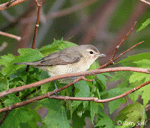 |
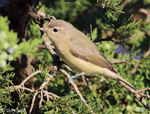 |
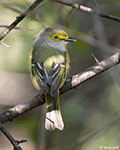 |
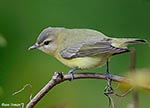 |
| Warbling Vireo | Warbling Vireo | White-eyed Vireo | Philadelphia Vireo |
Conservation Status:
Systematic surveys in recent years show populations of Bell's Vireos are increasing. They are found across a broad geographic area, are common in parts of that range, and overall populations are strong. Overall, the IUCN considers the Bell's Vireo to be a species of "Least Concern". However, there is a subspecies of Bell's Vireo in California and Baja California (often called the Least Bell's Vireo) that is considered federally endangered. Anthropogenic activity such as urban growth, land clearance for livestock grazing, and destruction of riparian vegetation are threats to this subspecies (and locally, to other populations).
South Dakota "Hotspot":
A key to finding Bell's Vireo in South Dakota is simply finding suitable brushy habitat. Note I often find them in the brushy lands bordering the Missouri River in the state. Particularly since fire is much less of a natural element to prairie ecosystems in the state than it used to be, the hilly lands around the Missouri River and its reservoirs often have areas of brushy thickets interspersed with eastern red cedar. The brushy thickets in these areas have been excellent places to find Bell's Vireo.
Further Information:
Photo Information:
July 5th, 2020 - Near Oahe Dam by Pierre - Terry Sohl
Additional Photos:
Click on the image chips or text links below for additional, higher-resolution Bell's Vireo photos.
Audio File Credits:
- 1Richard E. Webster - Recorded in Cochise County, Arizona on April 6th, 2020. Original recording and information available on xeno-canto.
- 2Jarrod Swackhamer. Recorded in Yuma County, Arizona on April 24th, 2020. Original recording and information available on xeno-canto.
- 3Richard E. Webster. Recorded in Cochise County, Arizona on June 7th, 2015. Original recording and information available on xeno-canto.
| Click on the map below for a higher-resolution view |
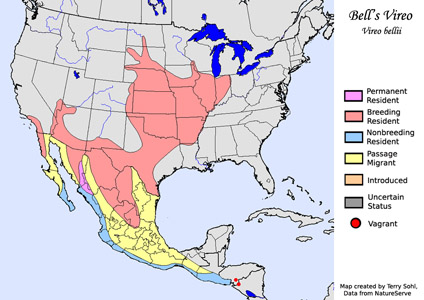 |
| South Dakota Status: Common migrant and summer resident in the south, especially along the Missouri River and its tributaries. |
Additional Bell's Vireo Photos
Click for a higher-resolution version of these photos
